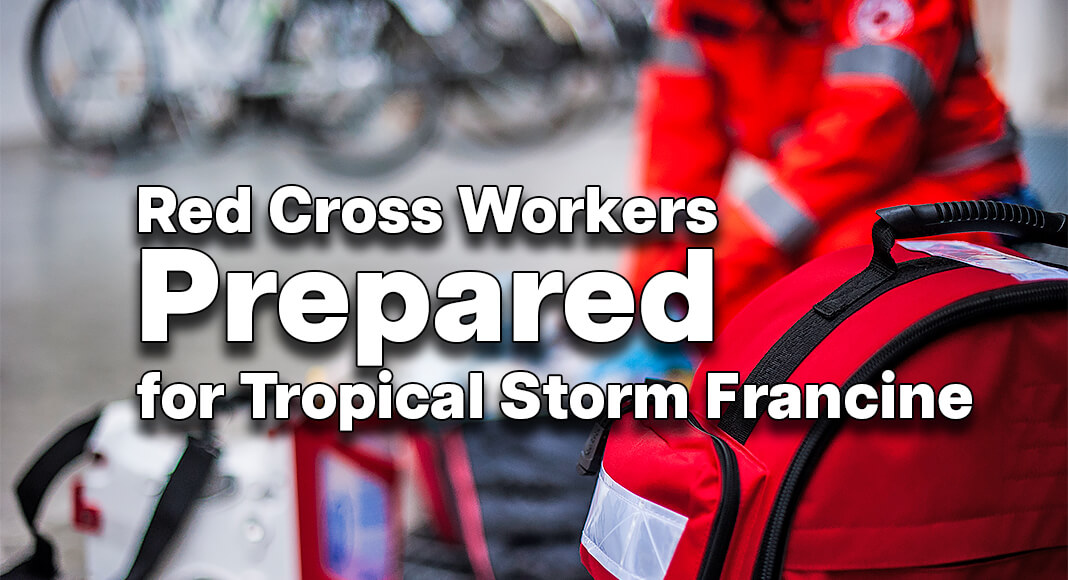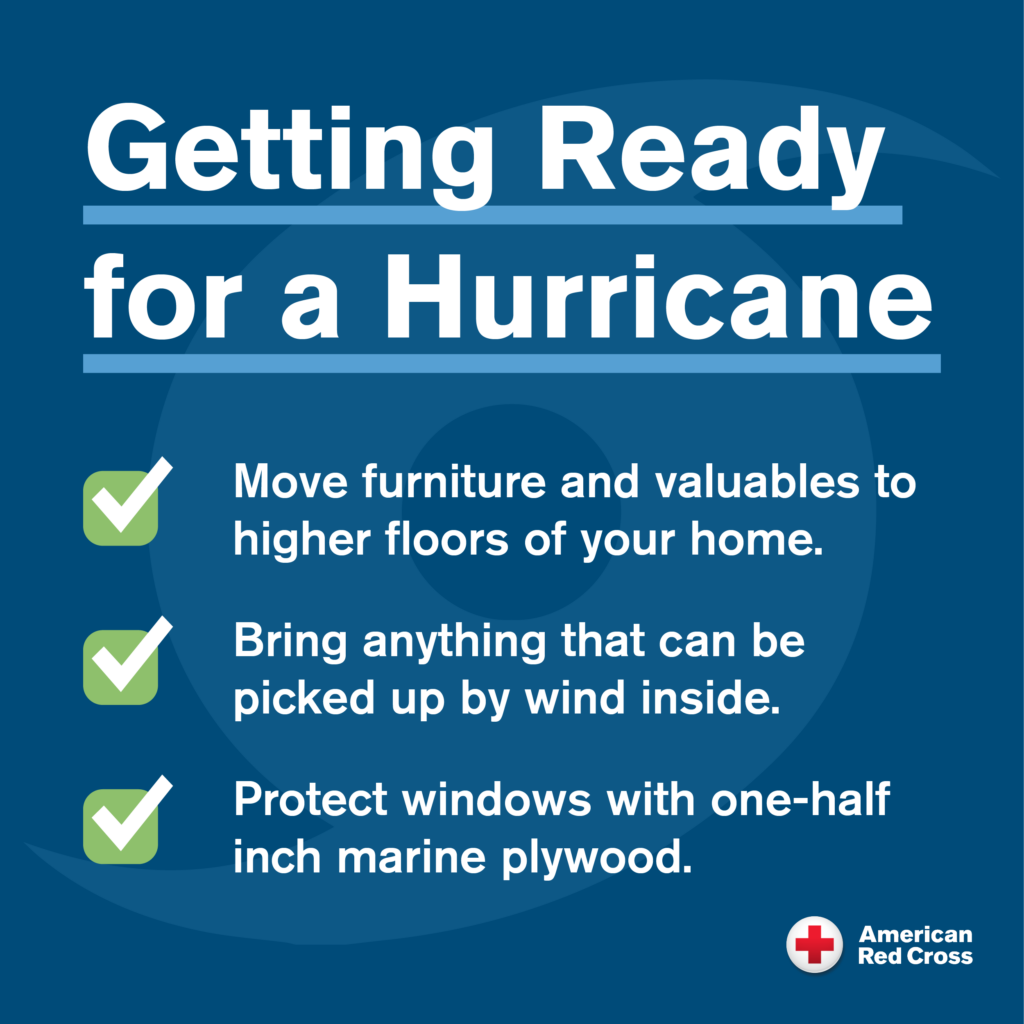
Texas Border Business
GULF COAST RED CROSS – Tropical Storm Francine is forecasted to strengthen into a Hurricane as it comes along the Texas Gulf Coast this week. The American Red Cross is preparing a large response effort and urges people in the path of the storm to get ready now.

“As Tropical Storm Francine draws closer to our coastline, many of our trained disaster response workers are in place and ready to help alongside equipment and supplies,” said Shawn Schulze, Chief Executive Officer for the Texas Gulf Coast Region. “We are in close contact with our community partners as we coordinate potential response efforts.”
The Red Cross has many disasters response trained volunteers ready to help. The Red Cross is pre-positioning trailer loads of sheltering supplies (cots, blankets), ready-to-eat meals, water and snacks, as well as clean-up kits and comfort kits containing personal hygiene items. The organization is also working in close collaboration with government officials and community partners to coordinate preparedness activities and potential response efforts.
This is a dangerous storm forecast to hit the U.S. with intense winds, heavy rain and a powerful storm surge. The Red Cross urges people in the path of this storm to finalize their own preparations now and follow the advice of emergency officials.
WHAT YOU SHOULD DO NOW
- Cover windows with storm shutters or plywood. Store outside items, such as lawn furniture and trash cans to prevent them from being moved by high winds and possibly hurting someone.
- Build an emergency kit with a gallon of water per person, per day, non-perishable food, a flashlight, battery-powered radio, first aid kit, medications, supplies for an infant if applicable, a multi-purpose tool, personal hygiene items, copies of important papers, cell phone chargers, extra cash, blankets, maps of the area and emergency contact information.
- If you have a disaster kit, make sure the food and water is still okay to consume and that copies of important documents are up to date.
- Keep insurance policies, documents, and other valuables in a safe-deposit box. Take pictures on a phone and keep copies of important documents and files on a USB flash drive that you can carry with you on your key ring.
- Fill your car’s gas tank in case an evacuation notice is issued.
- Never ride out a severe storm in a mobile home, even if it’s in a non-evacuation zone.
- Bring pets indoors and maintain direct control of them. Prepare an emergency kit for your pets with leashes or carriers, food, water, bowls, cat litter and box, and photos of you with your pet in case you are separated.
BE READY TO EVACUATE There are ten steps you can take now to be prepared if the storm makes it unsafe to stay home:
- The Red Cross urges people in the potential path of Tropical Storm Francine to get prepared now. Tune into your local radio, NOAA radio or news channels for the latest updates. Obey evacuation orders from local officials. Prepare to evacuate quickly and know your routes and destinations.
- Leave early enough to avoid being trapped by severe weather.
- If you don’t have a car, or can’t use your vehicle, plan on how you will leave the area.
- If you have a car, keep the gas tank full if an evacuation order is possible. Don’t let the tank go below half full in case gas stations are unable to pump gas.
- Decide where you would go and what route you would take to get there. This could be a motel, the home of a friend or relative a safe distance away, or an evacuation shelter. Download the free Red Cross Emergency App to find shelter information and weather and emergency alerts for more than 35 different situations.
- If you have time, let someone outside of the region know you are evacuating and where you are going. Leave a note saying when you left and where you plan to go.
- Wear sturdy shoes and protective clothing.
- Be alert for road hazards such as downed trees, flooding, etc. Do not drive onto a flooded road.
- Make sure you have locations and maps saved on devices such as cell phones, GPS units and paper.
- Don’t forget your pets. If it’s not safe for you to stay home, it’s not safe for them either. Prepare a phone list of pet-friendly motels and animal shelters located along your evacuation route. Keep in mind only service animals are usually allowed in shelters.
GET READY NOW A flood/flash flood WATCH means a flood or flash flood is possible. A flood/flash flood WARNING means flooding, or flash flooding is already occurring or will occur soon. Take immediate precautions.
Three simple steps can help to keep your family safe during disasters — 1) Get a Kit. 2) Make a Plan. 3) Be Informed.
- Build your emergency kit with a gallon of water per person, per day, non-perishable food, a flashlight and a battery-powered radio. Also include a first aid kit, medications, supplies for infants or pets, a multi-purpose tool and personal hygiene items. And don’t forget to add copies of important papers, cell phone chargers, blankets, maps of the area and emergency contact information.
- Plan what to do in case you are separated from your family during an emergency and what to do if you have to evacuate. Make sure to coordinate your plan with your child’s school, your work and your community’s emergency plans.
- Stay informed by finding out what emergency situations may occur where you live, work and go to school, how local officials will contact you during a disaster and how you will get important information, such as evacuation orders.
- Include your pets in your emergency plans. Remember, if you and your family need to evacuate, so does your pet. It’s important to plan in advance to know which pet-friendly hotels are in your area, and where your pets can stay in an emergency situation.
- Turn around, don’t drown! Stay off the roads. If you must drive and you encounter a flooded roadway, turn around and go another way.
- If you are caught on a flooded road and waters are rising around you, get out of the car quickly and move to higher ground.
- Tune into your local radio, NOAA radio or news channels for the latest updates. If your neighborhood is prone to flooding, prepare to evacuate quickly if necessary. Follow evacuation orders and don’t return until officials say it is safe.
- Stay away from floodwaters. Beware of snakes, insects and other animals that may be in or around floodwaters and your home.
- Keep children and pets away from hazardous sites and floodwaters.
- If power lines are down, don’t step in puddles or standing water.
HOW TO FIND A SHELTER
- Evacuation shelters are likely to open this week. Anyone who needs a safe place to go can find information for open Red Cross shelters in our free Red Cross Emergency App. Download the app by searching “American Red Cross” in your app store or by going to redcross.org/apps.
- Tropical Storm evacuation shelters are typically meant to shelter people for less than 24 hours as a tropical storm moves through. Often, space is extremely limited, and cots and blankets may not be available for each person. If there is enough lead time or it becomes evident that shelters will stay open after landfall, the Red Cross will move supplies from other areas to ensure people are as comfortable as possible for longer-term shelter stays.
- People who plan to stay in a Red Cross shelter should bring prescription medications, extra clothing, pillows, blankets, hygiene supplies, other comfort items and important documents. Don’t forget to bring any special items for children, such as diapers, formula and toys, or for family members who have unique needs.
- Red Cross shelters are open to everyone in need, regardless of race, religion, gender identity, sexual orientation or citizenship status. All disaster assistance is free. We don’t require people to show any kind of identification to enter a shelter — just their name and pre-disaster address.
- More information on hurricane safety and preparedness is available here.
HOW YOU CAN HELP
You can make a difference in the lives of people impacted by Tropical Storm Francine. Visit redcross.org, call 1-800-RED CROSS, or text the word Red Cross to 90999 to make a $10 donation. Donations enable the Red Cross to prepare for, respond to and help people recover from this disaster. This includes providing food, shelter, relief supplies, emotional support, recovery planning and other assistance. Ensure your donation helps people affected by disasters by choosing that option on redcross.org/donate or 1-800-RED CROSS.
About the American Red Cross:
The American Red Cross shelters, feeds and provides emotional support to victims of disasters; supplies about 40 percent of the nation’s blood; teaches skills that save lives; provides international humanitarian aid; and supports military members and their families. The Red Cross is a not-for-profit organization that depends on volunteers and the generosity of the American public to perform its mission. For more information, please visit redcross.org or cruzrojaamericana.org, or visit us on Twitter at @RedCross.















